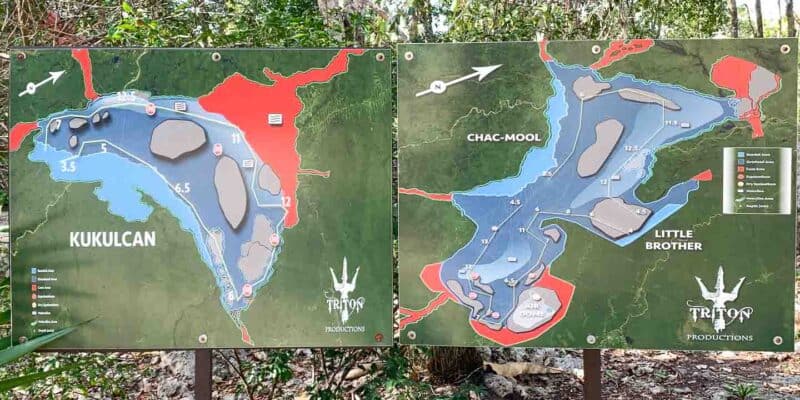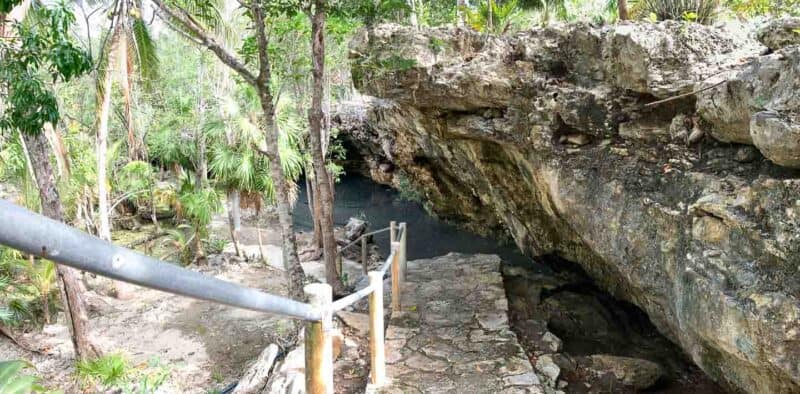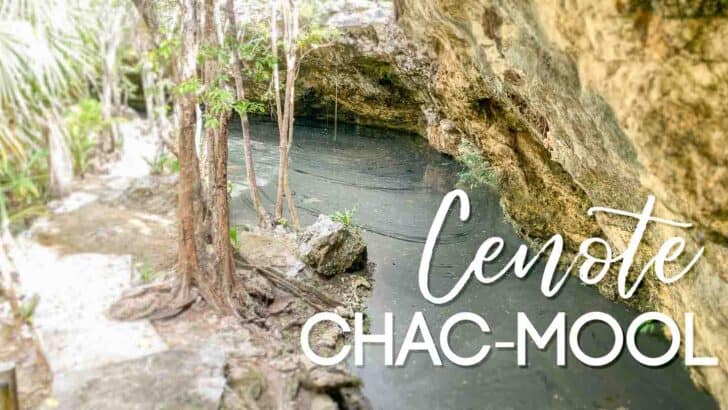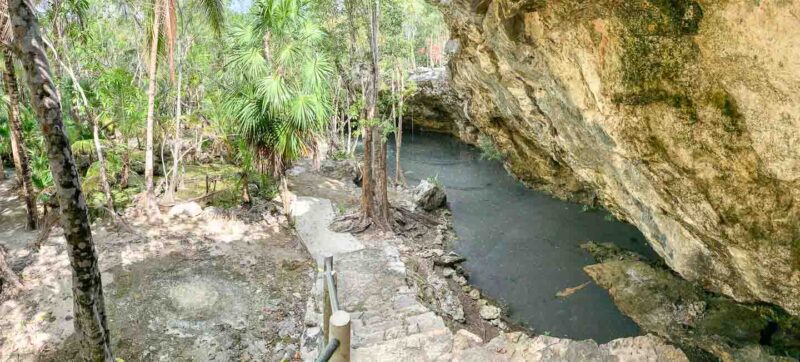When diving cenote Chac Mool, you’ll actually be swimming through 3 cenotes, all connected by an underground cave system. If you are looking for a cenote system with all aspects that make cenote diving amazing, Chac-Mool checks all the boxes.
Chac Mool is one of those cenotes you could dive several times and not see it all. In this article, I’ll go over everything you can expect when diving Chac Mool and why it’s one of my favorite cenotes in Mexico to dive.
Things to see while diving Chac Mool
Unfortunately or fortunately, cameras are not allowed inside Chac Mool. Once you dive into Cenote Chac Mool, you’ll understand why it is both good and bad.
However, I am writing this review of Cenote Chac Mool while my hair is still wet from the dive to help you picture (without many pictures) what to expect and why you should put this cenote high on your dive radar. Chac-Mool is a fascinating cenote with features large and small to dazzle you throughout the dive.
Chac Mool Cenote & Its Light Beams
One of the most impressive sights of this cenote system is the view as you approach the Chac Mool Cenote. Light pours into the narrow opening, and beams of light dance as they illuminate the sloping wall all the way to the cave entrances.
As you frog kick closer to the beams of light, you begin to notice all of the intricate details on the high-sloped wall leading to the water’s surface. Skeleton trees and rocks seem to terrace their way from about 6 meters up to the surface. I could have spent most of my dive time playing in the light beams and searching through the edge of Chac Mool Cenote.
Air Dome – Hydrogen Sulfide
Toward the end of the line on most dives is an area known as the air dome. In recent months, Chac Mool, the Air Dome, has been surrounded by a layer of hydrogen sulfide that covers the bottom except for the tallest stalagmites.
As you approach the air dome, the view is otherworldly, and if you didn’t know better, you might think you were landing on an alien planet. The suspended hydrogen sulfide also slightly reduces the visibility and makes the whole scene hazy, adding to the eerie feel.
To get a little bit of an idea of how this looks, check out some pictures from Cenote Angelita, which is famous for its Hydrogen Sulfide layer. What’s fascinating about Cenote Chac Mool’s hydrogen sulfide is that it occurs very close to the surface, and you have both natural light and the mystical cloud layer.
Cave Curtains
Long tall, and wide, nice examples of “Cave Curtains” can be found in Chac Mool. On the line between Little Brother and Kukulcan, keep your eye out and spot several nice cave curtains that look similar to an open curtain sitting ruffled next to a window.
Related: Best Places & Things To Do In Riviera Maya
Collapsed pieces of cenote ceiling
One feature of the cenote I found both fascinating and terrifying were the large sections of what used to be on the cave ceiling, now lying on the floor still with stalactites hanging from them. The cave formations now stick out at an unnatural 45-degree angle.
It also makes you ponder how and how long ago this part of the cave came to rest on the floor. The conclusion I came to while diving is that it would be bad to be in the cave when that happened.
Easter Eggs or Crystals of Chac Mool
Locally known as “Easter Eggs,” small pockets of crystals are present in many areas of Chac Mool. If your divemaster or local dive guide knows where to look, there are tons of crystals in Cenote Chac Mool.
Most are a hole about the size of a basketball filled with small colonies of short tan opaque crystals. These formations can be found in many cenotes, but Chac Mool holds many of them.

Cenote Chac Mool Dive Map
- Max Depth: 11-12 Meters
- Visibility: Fair in 2021 as far as cenotes go. A mixed-up Halocine layer and additional hydrogen sulfide result in a slightly reduced visibility, especially under 8 meters.
How to get to Cenote Chac-Mool
Chac-Mool is located 25km south of Playa Del Carmen off of the main 307 highway. A short ride down a dirt road brings you to the parking area with nice facilities, a small restaurant, and tables to assemble your dive gear. The cenote entrances are a 1-2 minute walk with a few concrete stairs with railings.
Chac Mool Meaning & Translation
Chacmool is the name of a commonly found statue in Mayan Culture, a stone figure in a laying or reclined position. The word is derived from the European discovery and excavation of the temple of Eagles and Jaguars at Chichen Itza in the 1800s. Experts say the closest translation of Chac-Mool is “paw swift like thunder,” – which is generally associated with the jaguars found in the area during the height of the Mayan Empire.
Cenote Chac Mool is named after this common figure in Mayan History. Why this name was chosen for this cenote is unclear. Many cenotes in the area were named by divers and are somewhat arbitrary and sometimes very random.

Things to know about diving Chac Mool
Cenote Chac Mool Halocline
In 2021, the Halocline is not currently a main draw to the cenote. Historically Chac Mool had a nice halocline. However, there is now a layer of hydrogen sulfide present. The Halocline is very close to the Hydrogen Sulfide, and I found it to be very mixed up for several meters and more of a distraction from the dive than a desirable razor-fine line between fresh and saltwater.
Hydrogen Sulfide in Chac Mool Cenote
A more recent occurrence in Cenote Chac Mool is a thin wispy layer of hydrogen sulfide. While this is cause for concern that some cenotes in the area possibly becoming contaminated. However, the resulting cloud layer does produce a fascinating effect – especially near the air dome.
Cameras are not allowed in Cenote Chac Mool
The cenote owner decided that many people are irresponsible while diving with a camera and causing damage to the cenote, so he banned them. In my opinion, this is both good and bad.
The bad part is that it is a beautiful cenote that I would love to photograph. Photos of amazing cenotes help people visit them and want to preserve them.
But I can see why they are banned – divers are generally more apt to bump into or kick cenote cave structures while focusing on photos than when they aren’t.
There are examples of stalactites all over Cenote Chac Mool that took thousands of years to form. It only takes one second to get snapped off and destroyed by a diver’s mistake.
More diving at Chac Mool
In addition to diving Chac Mool Cenote and Little Brother Lines, you can also dive Kukuclan as a separate dive. Kukulcan is part of the same system. However, permanent lines don’t exist between them.


myline
Friday 9th of April 2021
Are the ubers available near in this area?
Adam
Thursday 13th of May 2021
You won't find any ubers in this part of Mexico, you'll have to take a traditional taxi or Collectivo van.